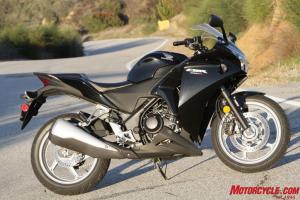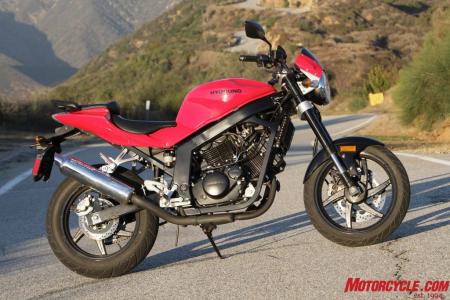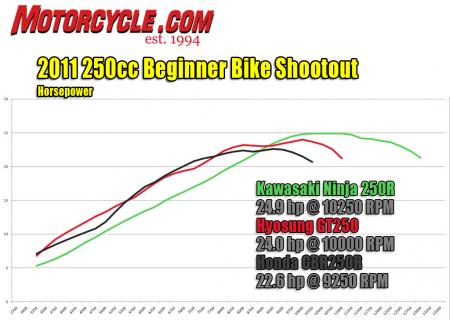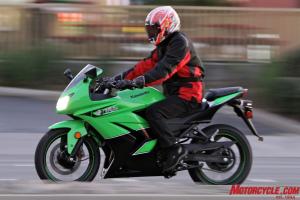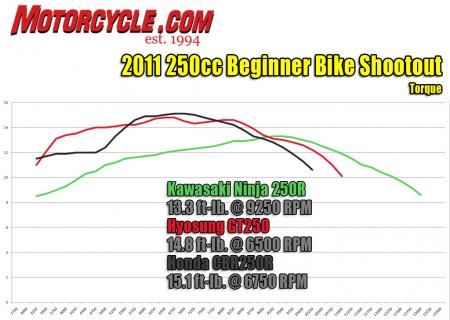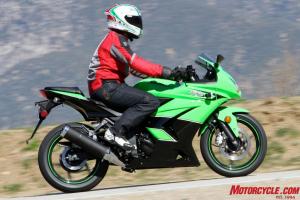As far as bike tests go, we’re going to go out on a limb and say this is the most important one we’ll do all year – and it’s only February.
Why is that? New riders are the holy grail for motorcycle manufacturers. It’s the reason they spend the money they do in advertising and promotions. The goal is to attract new riders to the brand, start them off with something small, like a 250, then keep them coming back and sticking to the brand as they progress through the ranks.
Beginner bikes: More than meets the eye
If you discount certain standards and cruisers that have popped up throughout the years, for over two decades, Kawasaki has had a stranglehold on the quarter-liter class with the machine everyone knows as the Ninja 250R. Consistently Kawasaki’s best-selling motorcycle, the little parallel-Twin doesn’t stick around for over two decades without a reason. It’s a solid machine that is a great building block for the new rider, yet still has enough pep in its step to keep a veteran rider satisfied.
By now you’ve probably read all about the Ninjette and its parallel-Twin engine, low seat height and spritely performance. If not you can refer to our previous test from the bike’s revamp in 2008 or in our2010 comparison to the Bennche Megelli 250. At any rate, we always thought it a mystery why none of the other Japanese manufacturers have tried to take a piece of that pie.
Until now, that is. Honda, seeing the potential goldmine that is the loyal repeat customer, is finally throwing its hat in the ring with the CBR250R. With all this time to study what makes the Kawasaki so great, Honda is taking a slightly different approach to new riders with the mini-CBR.
A key distinction is the fact that the CBR is powered by a single-cylinder engine. It, too, has dual overhead camshafts and four valves per cylinder (for a total of, uh, four), like the Kawasaki, but – here’s the kicker – it also has fuel injection! This alone gives the Honda an early lead in our book over the still-carbureted Kawasaki, but surely the penalty for EFI will be felt in the price tag, right?
Wrong. Both the Ninja 250 and CBR250R cost exactly the same at $3999. Our particular test bike however, came equipped with Honda’s combined ABS, a $500 option. The Kawasaki, unfortunately, isn’t available with ABS. With this interesting tale of the tape, we, just like you, were eager to discover just how the two matched up. Welcome to Motorcycle.com’s 2011 250cc beginner sporty-bike shootout.
But wait, we have a third bike to throw in the mix – Hyosung’s GT250, and it’s actually been available for a couple years now. While the Korean company hasn’t been getting the same recognition as its Japanese counterparts, the GT250 is what we consider the wildcard in this test. Powered by an air-cooled 249cc V-Twin, it’s the third different engine configuration of the bunch. This one also has dual overhead cams, four valves per cylinder and fuel injection.
We call it the wildcard because it costs $300 less than its Japanese rivals. In full disclosure, our original request was for the GT250R, which costs the same as the Kawasaki and Honda and comes with features like a full fairing, racy ergos, and dual front discs as opposed to the single disc on the standard, naked model. Unfortunately, Hyosung couldn’t get us one in time, but you can read more about it in our 2009 250cc Shootout.
Battle of the Buzzers
Starting the Honda and Hyosung in the morning is a matter of just pressing a button. Due to its carburetors, the Ninja requires the choke to give it some life when it’s cold outside. In this era of ubiquitous EFI, we found it annoying to have to wait for it to warm up.
The Ninja’s 249cc parallel-Twin engine hasn’t changed much throughout the years, and for better or worse, our testers found both high and low points about it. We admit it’s a bit strange to see a motorcycle that still has carbs, as playing with the choke and feeding the throttle during cold startups has all but become a thing of the past. Call it a history lesson for new riders, if you will.
Guest tester, Tom Roderick was especially critical of the fuel delivery, simply stating in his notes, “Carbs and choke...really?” Yes, Tom, really, though European versions of the Ninjette come with fuel injection, so don’t be surprised if that makes its way here in a 2012 update.
Despite this minor setback, the Kawasaki’s twin cylinders recorded the highest horsepower number as it spun the drum to the tune of 24.9 ponies on the Superflow dyno at Gene Thomason Racing. We expected as much since the twin-cylinder design is more efficient than a Single (Honda), and the liquid-cooling is superior to air-cooling (Hyosung).
Our butt-dyno also confirmed these numbers, as the Kawasaki was quick to leap away from the others once the engine was spinning past 9000 rpm, en route towards its 13,000-rpm redline. This proved to be fun when playing in the canyons or entering a highway onramp, but in the real world of everyday commuting and accelerating past cars, having to get the engine revving to keep it in the powerband required a lot of shifts through the six-speed gearbox and a deft clutch hand. Thankfully the transmission is smooth and clutch pulls are supremely light. Still, these attributes “make the Ninja difficult to ride around town compared to the Honda,” says Tom.
It’s no surprise the Ninette torque figures are also the lowest of the bunch, as we expected, with the parallel-Twin producing just over 13 ft.-lb. Though look at the dyno charts and you’ll notice no noticeable dips in the powerband, just a steady, progressive arc to the top. Carbs may be outdated, and these leanly tuned units deliver soft low-end response, but there isn’t an appreciable powerband dip until peak figures are made.
What’s interesting is where the other two machines stack up. As we expected, the CBR produces the least horsepower from its single cylinder – just 22.6 – but it trumps the rest in the torque department with 15.1 ft.-lbs. at 6500 rpm. More importantly, it already makes 11 ft.-lbs. at 3000 revs, where the Ninja is making just slightly more than eight.
What are they like to live with?
Of the three, the Ninja proved to be the least roomy of the bunch. Its seat pad lacks much length, so taller riders might feel a bit cramped. Despite its diminutive size, the Honda’s saddle actually feels like there’s more room to stretch out. But when it comes to “big bike feel,” the Hyosung again surprised us as it’s clearly the motorcycle that feels the most like its more grown-up siblings. The extended gas tank and seat pad mimic those of bigger motorcycles and would suit the taller or larger rider better. Not that the other two couldn’t, however.
Touching the ground is a big deal for new riders as it helps build confidence. Both the Ninja and the CBR have exact same seat heights, measuring 30.5 inches from the ground, which is relatively low for sport(y) bikes. The Hyosung, meanwhile, imitates its bigger siblings with a seat height of 32.7 inches. Again, something to consider for the taller/bigger rider, and perhaps something to be avoided for those with short legs.
Just look at the three bikes and it’s visibly clear that the Honda is the most compact of the bunch. The omission of a second cylinder as seen on the other two machines freed up space both horizontally and laterally, making for a compact machine that should appeal to women or riders of a smaller stature. It has the shortest wheelbase, too, at 53.9 inches compared to 55.1 inches on the Ninja and 56.5 on the GT250.
Another byproduct of the Honda’s missing cylinder is the weight difference between the other two bikes. The standard CBR250R tips the scales at a claimed 359 lbs., ready-to-ride and with a full tank of fuel. Add another eight pounds for the combined ABS system like the one on our test bike and it’s still eight pounds lighter than the other two, which both weigh 375 lbs.
The Honda’s torque advantage, coupled with its short first gear and light weight, give it the leap off the line over the other two. The Hyosung meanwhile, takes advantage of its broad torque curve to keep the Honda in its sights. It isn’t until they can stretch their legs does the Kawasaki then catch up.
Navigating through the city sprawl, and again the Honda’s torque and lightweight handling made it the easiest bike to maneuver around cars, through tight spaces, and while lane-splitting in the only state in the union that allows it.
On the highway the tables are turned slightly on the Honda. None of these machines are speed demons by any means, but accelerating up to merging speeds takes the better part of seven seconds. That’s still right on par with many four-wheelers on the road. The problem for the Honda is that the single cylinder is already spinning at 8500 rpm to maintain 80 mph, and as our own Kevin Duke put it, “there’s not much left in reserve at that speed.”
Remarkably, the Honda exhibits very minimal buzz or vibrations despite this engine speed. “This thing is smoother than a Single should be,” Roderick said, describing the Honda engine.
The Hyosung also struggles with passing power up top, as its 75-degree V-Twin redlines at 10,500, like the Honda. We also noticed a strange characteristic with the GT250 at speed: the entire bike would “weave” slowly across its axis when we hit a bump in the road. We’re not sure if it’s because of the bias-ply Shinko tires or some kind of chassis flex, but it was mildly disconcerting.
Meanwhile, it’s here on the highway that the Kawasaki really shines, as its engine is spinning at roughly the same speed as the rest, but it has a 13000 rpm redline, meaning it still has a few more ponies in reserve should they need to be called upon. Though we did notice the Ninja was the most vibey at highway speeds, especially when you did have to call upon the extra revs.
That being said, we really don’t see much need in having to go that quickly all the time. Plus, the majority of new riders stick to the streets and avoid the highways anyway. It’s because of its easy-to-ride and ideal-for-the-street nature that all of our testers were unanimous in picking the CBR250R as our choice for commuting and around-town duties.
We’re not done yet
But, just to appease our curiosity, we couldn’t help but give our trio a little romp in the twisties, too. This wasn’t all for naught, either, as the little Ninja 250R has been a long-time favorite for club racers across the country wanting to start their amateur careers. The Ninja’s revamp in 2008 reignited the club racing community’s enthusiasm in bringing back classes specifically for 250cc four-strokes. In fact, yours truly has competed on one in a previous life with moderate success.
Right away the Ninja’s and CBR’s racing heritage made itself clear; their handling was worlds better than the Hyosung. All three bikes have similar rake numbers (25 degrees for the Honda and Hyosung, 26 for the Kawasaki), but the Japanese bikes flick into turns much quicker. We suspect the Shinko tires are at least partially to blame as the radial IRC Road Winners on the Japanese bikes handled the canyon duties with ease.
Despite the fact that the GT250 is equipped with a 41mm inverted fork (the only one in this group with an inverted fork) and a preload-adjustable rear shock, it couldn’t overcome the handling woes the inferior rubber presented. All of our testers were timid pushing the bike, as the feedback from the rubber was minimal and it required the most effort to initiate turns. In fact, friend of Motorcycle.comand fellow guest tester Kaming Ko put it best, saying, “the bike moves from side to side like a belly dancer in the canyons and the freeway.”
As far as the Ninja and the CBR, both bikes are very similar in that each has 37mm, non-adjustable front forks, while the Green bike is equipped with Kawasaki’s Uni-Trak rear shock. Honda’s Pro-Link shock graces the rear of the CBR. Both units only feature pre-load adjustability. Despite the lack of adjustments, none of our testers complained about it. Duke, in fact, admired the suspenders on the Honda, calling it “dialed for a person of my 145-lb. weight. He went on to praise its compliance and decent control.
That being said, we were impressed with the suspensions on both bikes in the twisty bits. Each offered compliant rides that didn’t feel as soft as its bottom-bin parts would indicate. The one-degree rake difference was negligible when it came to turn-in. As we mentioned earlier, the weight advantage of the Honda proved to be equally important in the canyons as it was in the city. That’s because a large portion of that weight difference is due to the lack of reciprocating parts on a twin-cylinder like the Kawi and Hyosung, and it’s those gyroscopic forces that contribute to their slight lack of steering sharpness.
Of course, it’s not like the Kawi is a slouch; it apexes quickly and holds a line on par with the Honda, though it requires just that tiny bit more muscle. Again, with the engine spinning pretty high as they do in the tight bits, the Ninja simply pulls away from the Honda on corner exits.
This characteristic convinced us that the Kawi would be our preference to play with in the canyons or on the track. In casual street and commuting roles, we’ll take the torque of the Honda, but when it comes to sport riding or the racetrack, horsepower is still king.
Part of going fast is eventually slowing down, and we were genuinely pleased with the binders on all three bikes. Despite sharing heaviest bike honors with the Hyosung, the Ninja has a single petal-type front rotor measuring 290mm, while the Korean bike sports a single 300mm disc. The Honda splits the difference with a 296mm disc. All three are mated to two-piston calipers.
We couldn’t fault any of the binders as they all delivered impressive stopping power in light of their budget-conscious origins, but considering new riders worry about how much front brake they can use, the Honda’s combined ABS again takes the nod for top honors as the system works so fluidly and will undoubtedly bring these new rider worries to rest. Though one quibble we had was that tapping the rear brake mid-corner would cause the front to dive noticeably. That’s something we’d gladly live with for the peace of mind it provides while trying to navigate the urban sprawl.
At the end of the day we were split between the Ninja and CBR when it came to spirited riding. Half the group enjoyed the Honda’s agility, while the other half favored the Kawasaki’s power. Consider this category a draw.
So what’ll it be?
The easy answer to that question is “all of them.” And, really, it’s true – for the new rider, you can’t go wrong choosing any of these bikes. Apart from the aforementioned riding impressions, all three will be cheap to insure, easy to ride, and will go a long way before you need to look for a gas station.
But a winner has to be chosen, and it’s here where we split hairs. All of us were genuinely surprised at the Hyosung’s performance. The V-Twin provides a nice compromise between torque and horsepower in an air-cooled engine, and its fuel-injection provides a definite advantage over the Ninja. Ergonomically, it was the most spacious as well. It even averaged 53 mpg – second best in the group. At $3699 it’s also the least expensive.
That’s where the praise ends, however. We couldn’t get past the flighty handling of the GT250, and it was the most difficult to maneuver. The transmission felt notchy, and overall fit and finish isn’t yet level with its Japanese rivals. Despite its two-year warranty, we’re still cautious about Hyosung’s parts and dealer network. It’s for these reasons we put the GT250 in third place.
It almost feels wrong calling the Ninja 250 our second-place machine, as it’s been the only game in town and it’s still such a capable performer. In its element, the parallel-Twin is the liveliest of the bunch, and it’s the best bike of this trio for running long distances on the highway. Its transmission and suspension leave nothing to be desired, either. Not only that, but the support network is so huge and enthusiastic that there’s practically nothing you can’t do to this bike.
Despite that, there are still some chinks in its armor. First and foremost: the carburetors. Our European neighbors don’t have them anymore. Why do we? Not only that, but the Ninja also delivered the worst fuel mileage of the bunch by far at 43 mpg. Some may find the seating arrangement a little cramped as well. Ultimately, we gave it second place because around town the Ninja 250 is a handful to keep in the powerband; and when you only have 26 horses, you try and take advantage of them whenever possible.
Then there’s the CBR250R. We instantly fell in love with this bike around town, as it’s comfortable, light, and, best of all, its class-leading torque is easily accessible. It also managed to win the mileage game too, clocking an impressive 57 mpg in our combined riding. We think the new rider will benefit most from all these attributes when going to school, commuting to work, or just bombing around town. We wouldn’t say the ABS is a must-have, but if it provides the new rider with confidence, then it’s worth the extra 500 bones.
That’s not to say the Honda is without its downfalls. Really, the only glaring one is that its paltry 22 horses are barely enough to keep up with traffic. Since it’s so new, there’s no telling what the parts and dealer network will be like, but since it’s a Honda we’re not too worried about that.
There you have it. Our 2011 beginner bike showdown is in the books and Honda has finally wrestled the crown away from the long-time king. Fortunately, no matter how you slice it, the real winners are us, the riding public.
Source : motorcycle.com
Why is that? New riders are the holy grail for motorcycle manufacturers. It’s the reason they spend the money they do in advertising and promotions. The goal is to attract new riders to the brand, start them off with something small, like a 250, then keep them coming back and sticking to the brand as they progress through the ranks.
Beginner bikes: More than meets the eye
If you discount certain standards and cruisers that have popped up throughout the years, for over two decades, Kawasaki has had a stranglehold on the quarter-liter class with the machine everyone knows as the Ninja 250R. Consistently Kawasaki’s best-selling motorcycle, the little parallel-Twin doesn’t stick around for over two decades without a reason. It’s a solid machine that is a great building block for the new rider, yet still has enough pep in its step to keep a veteran rider satisfied.
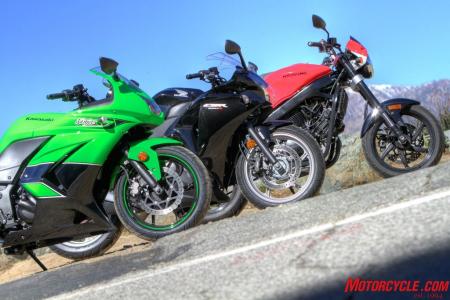 Thanks to the Kawasaki Ninja 250R, Honda CBR250R and Hyosung GT250, there has never been a better time to be a new rider. |
Until now, that is. Honda, seeing the potential goldmine that is the loyal repeat customer, is finally throwing its hat in the ring with the CBR250R. With all this time to study what makes the Kawasaki so great, Honda is taking a slightly different approach to new riders with the mini-CBR.
A key distinction is the fact that the CBR is powered by a single-cylinder engine. It, too, has dual overhead camshafts and four valves per cylinder (for a total of, uh, four), like the Kawasaki, but – here’s the kicker – it also has fuel injection! This alone gives the Honda an early lead in our book over the still-carbureted Kawasaki, but surely the penalty for EFI will be felt in the price tag, right?
Wrong. Both the Ninja 250 and CBR250R cost exactly the same at $3999. Our particular test bike however, came equipped with Honda’s combined ABS, a $500 option. The Kawasaki, unfortunately, isn’t available with ABS. With this interesting tale of the tape, we, just like you, were eager to discover just how the two matched up. Welcome to Motorcycle.com’s 2011 250cc beginner sporty-bike shootout.
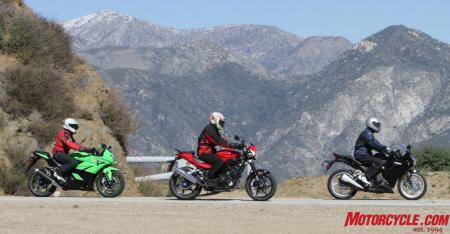 Same displacement, three different configurations. Which will win beginner bike glory? |
We call it the wildcard because it costs $300 less than its Japanese rivals. In full disclosure, our original request was for the GT250R, which costs the same as the Kawasaki and Honda and comes with features like a full fairing, racy ergos, and dual front discs as opposed to the single disc on the standard, naked model. Unfortunately, Hyosung couldn’t get us one in time, but you can read more about it in our 2009 250cc Shootout.
Battle of the Buzzers
Starting the Honda and Hyosung in the morning is a matter of just pressing a button. Due to its carburetors, the Ninja requires the choke to give it some life when it’s cold outside. In this era of ubiquitous EFI, we found it annoying to have to wait for it to warm up.
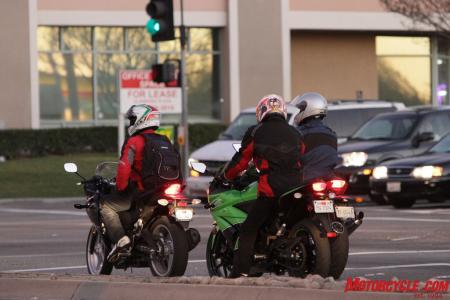 The majority of new riders will find themselves riding in this situation; commuting to and fro on city streets. So that’s the environment we tested them in. |
Guest tester, Tom Roderick was especially critical of the fuel delivery, simply stating in his notes, “Carbs and choke...really?” Yes, Tom, really, though European versions of the Ninjette come with fuel injection, so don’t be surprised if that makes its way here in a 2012 update.
Despite this minor setback, the Kawasaki’s twin cylinders recorded the highest horsepower number as it spun the drum to the tune of 24.9 ponies on the Superflow dyno at Gene Thomason Racing. We expected as much since the twin-cylinder design is more efficient than a Single (Honda), and the liquid-cooling is superior to air-cooling (Hyosung).
Our butt-dyno also confirmed these numbers, as the Kawasaki was quick to leap away from the others once the engine was spinning past 9000 rpm, en route towards its 13,000-rpm redline. This proved to be fun when playing in the canyons or entering a highway onramp, but in the real world of everyday commuting and accelerating past cars, having to get the engine revving to keep it in the powerband required a lot of shifts through the six-speed gearbox and a deft clutch hand. Thankfully the transmission is smooth and clutch pulls are supremely light. Still, these attributes “make the Ninja difficult to ride around town compared to the Honda,” says Tom.
It’s no surprise the Ninette torque figures are also the lowest of the bunch, as we expected, with the parallel-Twin producing just over 13 ft.-lb. Though look at the dyno charts and you’ll notice no noticeable dips in the powerband, just a steady, progressive arc to the top. Carbs may be outdated, and these leanly tuned units deliver soft low-end response, but there isn’t an appreciable powerband dip until peak figures are made.
What’s interesting is where the other two machines stack up. As we expected, the CBR produces the least horsepower from its single cylinder – just 22.6 – but it trumps the rest in the torque department with 15.1 ft.-lbs. at 6500 rpm. More importantly, it already makes 11 ft.-lbs. at 3000 revs, where the Ninja is making just slightly more than eight.
What are they like to live with?
Of the three, the Ninja proved to be the least roomy of the bunch. Its seat pad lacks much length, so taller riders might feel a bit cramped. Despite its diminutive size, the Honda’s saddle actually feels like there’s more room to stretch out. But when it comes to “big bike feel,” the Hyosung again surprised us as it’s clearly the motorcycle that feels the most like its more grown-up siblings. The extended gas tank and seat pad mimic those of bigger motorcycles and would suit the taller or larger rider better. Not that the other two couldn’t, however.
Touching the ground is a big deal for new riders as it helps build confidence. Both the Ninja and the CBR have exact same seat heights, measuring 30.5 inches from the ground, which is relatively low for sport(y) bikes. The Hyosung, meanwhile, imitates its bigger siblings with a seat height of 32.7 inches. Again, something to consider for the taller/bigger rider, and perhaps something to be avoided for those with short legs.
Just look at the three bikes and it’s visibly clear that the Honda is the most compact of the bunch. The omission of a second cylinder as seen on the other two machines freed up space both horizontally and laterally, making for a compact machine that should appeal to women or riders of a smaller stature. It has the shortest wheelbase, too, at 53.9 inches compared to 55.1 inches on the Ninja and 56.5 on the GT250.
Another byproduct of the Honda’s missing cylinder is the weight difference between the other two bikes. The standard CBR250R tips the scales at a claimed 359 lbs., ready-to-ride and with a full tank of fuel. Add another eight pounds for the combined ABS system like the one on our test bike and it’s still eight pounds lighter than the other two, which both weigh 375 lbs.
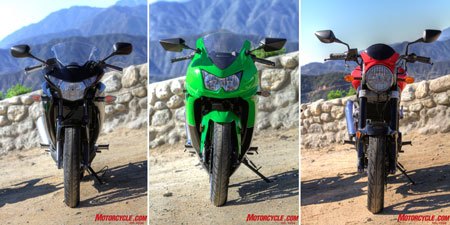 Of the three, the Honda was the slimmest and most compact of the bunch. Don’t be fooled by the Hyosung’s nakedness - from the saddle it feels like a much bigger machine. |
Navigating through the city sprawl, and again the Honda’s torque and lightweight handling made it the easiest bike to maneuver around cars, through tight spaces, and while lane-splitting in the only state in the union that allows it.
On the highway the tables are turned slightly on the Honda. None of these machines are speed demons by any means, but accelerating up to merging speeds takes the better part of seven seconds. That’s still right on par with many four-wheelers on the road. The problem for the Honda is that the single cylinder is already spinning at 8500 rpm to maintain 80 mph, and as our own Kevin Duke put it, “there’s not much left in reserve at that speed.”
Remarkably, the Honda exhibits very minimal buzz or vibrations despite this engine speed. “This thing is smoother than a Single should be,” Roderick said, describing the Honda engine.
The Hyosung also struggles with passing power up top, as its 75-degree V-Twin redlines at 10,500, like the Honda. We also noticed a strange characteristic with the GT250 at speed: the entire bike would “weave” slowly across its axis when we hit a bump in the road. We’re not sure if it’s because of the bias-ply Shinko tires or some kind of chassis flex, but it was mildly disconcerting.
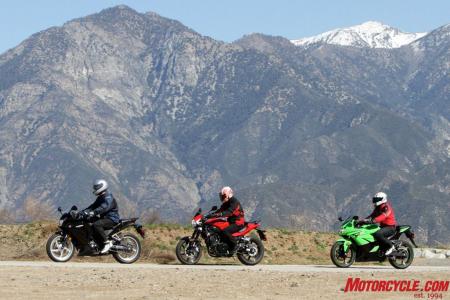 Each of these three machines impressed us in one way or another. A new rider can’t go wrong with any of them. |
That being said, we really don’t see much need in having to go that quickly all the time. Plus, the majority of new riders stick to the streets and avoid the highways anyway. It’s because of its easy-to-ride and ideal-for-the-street nature that all of our testers were unanimous in picking the CBR250R as our choice for commuting and around-town duties.
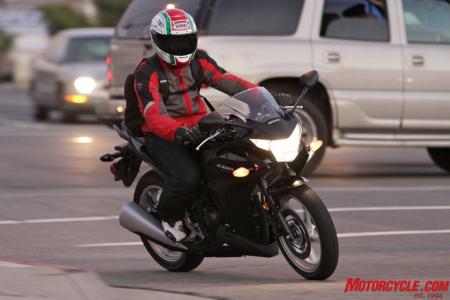 The Honda CBR250R is our pick if you’re a new rider trying to surviving the urban jungle. |
But, just to appease our curiosity, we couldn’t help but give our trio a little romp in the twisties, too. This wasn’t all for naught, either, as the little Ninja 250R has been a long-time favorite for club racers across the country wanting to start their amateur careers. The Ninja’s revamp in 2008 reignited the club racing community’s enthusiasm in bringing back classes specifically for 250cc four-strokes. In fact, yours truly has competed on one in a previous life with moderate success.
Right away the Ninja’s and CBR’s racing heritage made itself clear; their handling was worlds better than the Hyosung. All three bikes have similar rake numbers (25 degrees for the Honda and Hyosung, 26 for the Kawasaki), but the Japanese bikes flick into turns much quicker. We suspect the Shinko tires are at least partially to blame as the radial IRC Road Winners on the Japanese bikes handled the canyon duties with ease.
 The racing heritage of the bigger Ninjas and CBRs is evident while riding these miniature versions. |
As far as the Ninja and the CBR, both bikes are very similar in that each has 37mm, non-adjustable front forks, while the Green bike is equipped with Kawasaki’s Uni-Trak rear shock. Honda’s Pro-Link shock graces the rear of the CBR. Both units only feature pre-load adjustability. Despite the lack of adjustments, none of our testers complained about it. Duke, in fact, admired the suspenders on the Honda, calling it “dialed for a person of my 145-lb. weight. He went on to praise its compliance and decent control.
 Bias-ply Shinko tires on the Hyosung contributed to its less-than-planted feeling and skittish reaction over road imperfections. The amount of feedback was disappointing. |
Of course, it’s not like the Kawi is a slouch; it apexes quickly and holds a line on par with the Honda, though it requires just that tiny bit more muscle. Again, with the engine spinning pretty high as they do in the tight bits, the Ninja simply pulls away from the Honda on corner exits.
This characteristic convinced us that the Kawi would be our preference to play with in the canyons or on the track. In casual street and commuting roles, we’ll take the torque of the Honda, but when it comes to sport riding or the racetrack, horsepower is still king.
Part of going fast is eventually slowing down, and we were genuinely pleased with the binders on all three bikes. Despite sharing heaviest bike honors with the Hyosung, the Ninja has a single petal-type front rotor measuring 290mm, while the Korean bike sports a single 300mm disc. The Honda splits the difference with a 296mm disc. All three are mated to two-piston calipers.
 All three bikes provide impressive stopping power, but we feel the Honda’s optional combined-ABS will suit new riders best. |
At the end of the day we were split between the Ninja and CBR when it came to spirited riding. Half the group enjoyed the Honda’s agility, while the other half favored the Kawasaki’s power. Consider this category a draw.
 It’s hard to pick a favorite when they’re all so close. |
The easy answer to that question is “all of them.” And, really, it’s true – for the new rider, you can’t go wrong choosing any of these bikes. Apart from the aforementioned riding impressions, all three will be cheap to insure, easy to ride, and will go a long way before you need to look for a gas station.
But a winner has to be chosen, and it’s here where we split hairs. All of us were genuinely surprised at the Hyosung’s performance. The V-Twin provides a nice compromise between torque and horsepower in an air-cooled engine, and its fuel-injection provides a definite advantage over the Ninja. Ergonomically, it was the most spacious as well. It even averaged 53 mpg – second best in the group. At $3699 it’s also the least expensive.
That’s where the praise ends, however. We couldn’t get past the flighty handling of the GT250, and it was the most difficult to maneuver. The transmission felt notchy, and overall fit and finish isn’t yet level with its Japanese rivals. Despite its two-year warranty, we’re still cautious about Hyosung’s parts and dealer network. It’s for these reasons we put the GT250 in third place.
It almost feels wrong calling the Ninja 250 our second-place machine, as it’s been the only game in town and it’s still such a capable performer. In its element, the parallel-Twin is the liveliest of the bunch, and it’s the best bike of this trio for running long distances on the highway. Its transmission and suspension leave nothing to be desired, either. Not only that, but the support network is so huge and enthusiastic that there’s practically nothing you can’t do to this bike.
Despite that, there are still some chinks in its armor. First and foremost: the carburetors. Our European neighbors don’t have them anymore. Why do we? Not only that, but the Ninja also delivered the worst fuel mileage of the bunch by far at 43 mpg. Some may find the seating arrangement a little cramped as well. Ultimately, we gave it second place because around town the Ninja 250 is a handful to keep in the powerband; and when you only have 26 horses, you try and take advantage of them whenever possible.
 The Ninja 250R is the best choice for sportbike duties, but it falls behind due to its peakier powerband caused by lean carburetor jetting. |
That’s not to say the Honda is without its downfalls. Really, the only glaring one is that its paltry 22 horses are barely enough to keep up with traffic. Since it’s so new, there’s no telling what the parts and dealer network will be like, but since it’s a Honda we’re not too worried about that.
There you have it. Our 2011 beginner bike showdown is in the books and Honda has finally wrestled the crown away from the long-time king. Fortunately, no matter how you slice it, the real winners are us, the riding public.
 Honda’s CBR250R is our choice when it comes to a machine that is best suited towards new riders. |
Source : motorcycle.com
